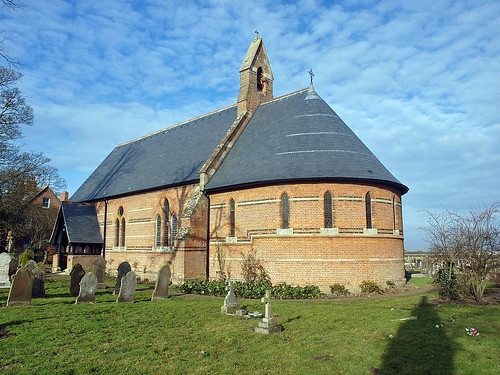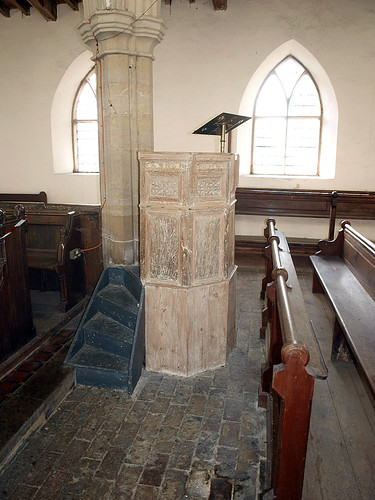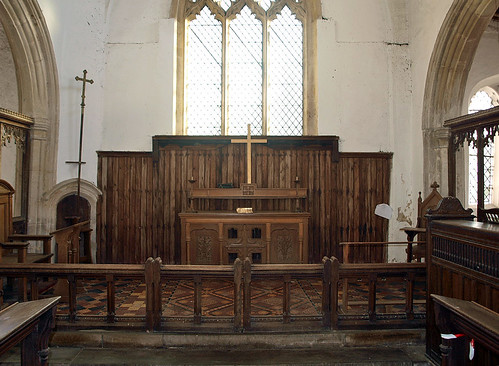EMMANUEL CHURCH (Southea). Red brick, with some blue bricks. Nave and N aisle on short circular piers. Bell-cote between nave and wide semicircular apse. The brickwork is exposed inside. The window tracery is in imitation of the late C13 or early C14. The date of the church is 1872.
ST JOHN (Church End). Fine Perp W tower with tall panelled arch towards the nave, large three-light windows, tierceron vault with wide circular opening for the bell ropes, and battlements. The N aisle is older. It has a C13 doorway and walls and windows of the earlier C14. The S aisle was largely rebuilt in the C19. Fine interior, even if deprived of its chancel, which was, it is said, destroyed by a flood in 1613. The nave is seven bays long and has Perp arcades with slim piers the main shafts of which are semi-polygonal. The arches are nearly round. The W bays are cut into by E reinforcements of the tower. The clerestory windows are of three lights. - FONT. Octagonal, Perp, big with elaborate quatrefoil panels on the bowl, and tracery on the stem. - PULPIT. Dated 1677. - PLATE. Late C15 Paten, the only unaltered piece of medieval plate in a Cambridgeshire church, says the VCH. In its centre the Vernicle. - Chalice of 1599.
PARSON DROVE. A few years after the war we came here in search of the last woad mill in Cambridgeshire, believed to be the last in England, but, alas, we came to find only a plant of bright yellow flowers and blue-green leaves growing in the corner of a garden. It was all that was left of acres of woadplants which grew here almost to the beginning of our century. The woad mill was no more. It had fallen to pieces and been removed, together with the balls of woad pulp the mill crushed, to Wisbech Museum, where we may see it as a rather melancholy relic.
It was Julius Caesar who first instilled into the minds of civilised people the fact that some of our ancestors dyed their skins with the blue dye obtained from the woad plant. In his Gallic War we read that “ without exception all the Britons stain themselves with woad, which produces a blue tint; and this gives them a wild appearance in a fight.” There is little doubt that Caesar libelled the brave race which so vigorously resisted his legions; if woad was used for staining the bare skin of the warriors it was used quite as much in giving a brilliant colour (rather like a natural indigo) to their clothes. It was the beginning of brighter fashions in dress.
Woad dye was obtained from the crushed leaves of a plant which grows still in many gardens, the botanical name being Isatis tinctoria. Growing from one to six feet high, it has branching flower-stalks with yellow blossoms and small pods. It was from the blue-green leaves that the dye was obtained.
Many people still in Cambridgeshire remember the woad crops of their fertile soil. For over 2000 years the industry thrived until modern discoveries and modern machinery killed it. The young woad plants were delicate and needed much care, and men and women crawled along the field removing the weeds with a tiny spade fitting into the palm of their hands. When the plant was picked the leaves, having been crushed to pulp in a primitive horse-worked mill, were moulded by hand into balls, which were laid out in sheds to dry, and after three months the balls were mixed with water and put in a dark chamber to ferment for about six weeks, when they were ripe for despatch to the cloth manufacturers.
The woad-mill village lies on one of the roads which are so straight hereabouts that we only lose them in the distance, and the church tower, rising in the trees, is like a beacon in the flat countryside. It is a 15th century tower with bosses of roses and men’s heads in the vaulted roof, and a great panelled arch reaching the full height of the nave.
We may come into this light church by a 13th century or a 15th century doorway, both sheltered by massive porches. The nave has striking 15th century arcades of seven bays, with an east window where an arch opened to a chancel till it was swept away in a flood 300 years ago. There is a little old glass set in the clear windows. The font is 15th century and the pulpit Jacobean, and a silver paten with an engraving of the head of Our Lord is the only piece of Communion plate in the county left untouched by the Reformation.
It was Julius Caesar who first instilled into the minds of civilised people the fact that some of our ancestors dyed their skins with the blue dye obtained from the woad plant. In his Gallic War we read that “ without exception all the Britons stain themselves with woad, which produces a blue tint; and this gives them a wild appearance in a fight.” There is little doubt that Caesar libelled the brave race which so vigorously resisted his legions; if woad was used for staining the bare skin of the warriors it was used quite as much in giving a brilliant colour (rather like a natural indigo) to their clothes. It was the beginning of brighter fashions in dress.
Woad dye was obtained from the crushed leaves of a plant which grows still in many gardens, the botanical name being Isatis tinctoria. Growing from one to six feet high, it has branching flower-stalks with yellow blossoms and small pods. It was from the blue-green leaves that the dye was obtained.
Many people still in Cambridgeshire remember the woad crops of their fertile soil. For over 2000 years the industry thrived until modern discoveries and modern machinery killed it. The young woad plants were delicate and needed much care, and men and women crawled along the field removing the weeds with a tiny spade fitting into the palm of their hands. When the plant was picked the leaves, having been crushed to pulp in a primitive horse-worked mill, were moulded by hand into balls, which were laid out in sheds to dry, and after three months the balls were mixed with water and put in a dark chamber to ferment for about six weeks, when they were ripe for despatch to the cloth manufacturers.
The woad-mill village lies on one of the roads which are so straight hereabouts that we only lose them in the distance, and the church tower, rising in the trees, is like a beacon in the flat countryside. It is a 15th century tower with bosses of roses and men’s heads in the vaulted roof, and a great panelled arch reaching the full height of the nave.
We may come into this light church by a 13th century or a 15th century doorway, both sheltered by massive porches. The nave has striking 15th century arcades of seven bays, with an east window where an arch opened to a chancel till it was swept away in a flood 300 years ago. There is a little old glass set in the clear windows. The font is 15th century and the pulpit Jacobean, and a silver paten with an engraving of the head of Our Lord is the only piece of Communion plate in the county left untouched by the Reformation.



No comments:
Post a Comment